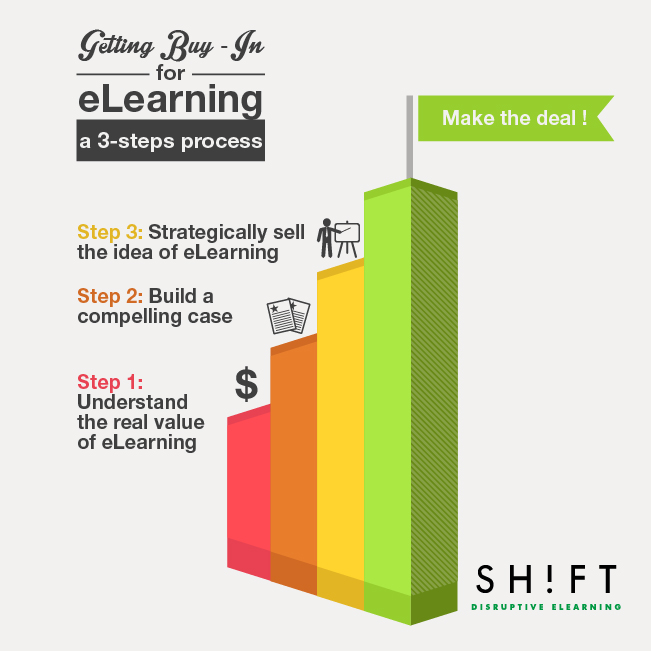More and more companies today have invested or are starting to invest in an online learning program. Regardless of their size and type these companies realized that eLearning just makes good business sense.
But not everyone, however, is convinced of utilizing eLearning or online learning for training. Not even your boss.
The good news is, it isn't that difficult to sell eLearning to management. It can be a bit challenging, yes, but never insurmountable. In fact, 41.7% of Fortune 500 Companies worldwide have already implemented eLearning strategies. That's a good proof that the technology—when planned and implemented well—can help companies gain enormous benefits.
Here's a three-step process to help you convince your boss, your CEO, your management team or even a client of the need to embrace eLearning:

Step 1: Understand the Real Value of eLearning
You can't fool company executives by presenting them a list of organizations that have successfully adopted eLearning. But you can, however, help them understand the true benefit of the technology by understanding it yourself first. Be sure to tackle these key points during your initial discussions:
- Faster time to market: eLearning undoubtedly has faster delivery cycle times than a traditional, classroom-based instruction. It is also not limited by the number of available trainers and classrooms. Thus, eLearning can facilitate your organization responds proactively to change by making sure employees have superior knowledge and skills.
- Cost-effectiveness: eLearning effectively reduces both training time and cost of staff needed during the course of training. In fact, a Brandon-Hall Study, reported that eLearning requires from 40% to 60% less employee time than the same material delivered in a traditional classroom setting. It immediately eliminates direct delivery costs including transportation, accommodation, printing time and distribution. Consequently, it improves worker productivity since it's considerably quicker than the classroom-based alternative. No need to schedule rooms or travel to another building.
- Active engagement: eLearning can help increase participant engagement and improve employees' learning experience and productivity. People learn more and faster just by being able to choose what, when and how to learn. They can, for instance, access learning materials anytime and anywhere, regardless of the device. IBM has already done this with its own eLearning program for managers. The company, after rolling out an eLearning program, found that participants learned nearly 5X more material without increasing time spent training. (Article: eLearning Success- measuring the ROI impact and benefits, May 2013).
- Easier, cheaper, quicker to update and scalable: eLearning technology is flexible enough to allow new regulations and materials to be incorporated quickly into an existing program. More importantly, eLearning is very much scalable. You can reach more learners—from a few dozens today to hundreds tomorrow—at a minimal cost and effort since the materials are generated and distributed electronically.
- Enhanced customer revenues: Customers in dire need of training to use a product or service are willing to pay handsomely for it. In fact, Microsoft and IBM are making a lot of money out of customer training.
Step 2: Build a Compelling Case
Knowing what to argue or present is one thing. Building a solid case for eLearning is another. An article published in ATD, suggests that you cover the following elements when discussing your business case for eLearning:
- Problem statement: In a few sentences or one short paragraph, state the specific business problem clearly.
- Background: Indicate issues or problems that need to be solved or reduced. Be sure to include information that may contribute to the business problem such as skills, performance and budgeting.
- Objectives: In no more than seven bullet points, present your project objectives or proposed solutions.
- Current Process: Identify organizations processes that the above objectives may affect. In addition to your training department, there might be other departments or outside partners that may be involved or affected once the project starts.
- Requirements: List down all resources, from staff to software, needed to complete the project.
- Alternatives: List down at least four alternative options for implementing the project. Compare and contrast each option.
- Additional considerations: There may be other critical success factors your organization values highly. ROI metrics and partnership agreements are just a few examples.
- Action plan: Outline your concrete action steps. Include short-term and long-term action plans, and as well as major milestones.
- Executive summary: Offer a one-page summary of your proposed eLearning solution. Tailor the language to your audience. More often than not, it helps if you mention examples of companies that have successfully implemented a similar plan.
Also, find some hard statistics to impress your company's executives and make your point even clearer. Remember, these people are really busy, so be ready to present your facts quickly and visually. So where can you find such a set of stats? Here’re some articles you’ll want to check out:
- 15 Facts and Stats That Reveal The Power Of eLearning
- Global Investments in eLearning to Double by 2015 [Infographic]
- The Benefits of E-Learning: Key Data For your eLearning Business Case
- Calculating the ROI of eLearning
- eLearning Benefits and Statistics: Reach More Learners in Less Time
- Why eLearning?
Step 3: Strategically Sell the Idea of eLearning
How you argue for eLearning can either make or break your business case. So presentation is everything. The key is to sell your idea strategically to decision-makers and stakeholders. At all times, demonstrate sound judgment and common sense.
Here are some other important points to consider:
- Be prepared for tough questions, especially those rapidly fired by your company executives.
- Aim for simplicity and clarity in your presentation. Start by keeping the jargon out of the conversation. Try to explain the main idea without even using the technical words (LMS or SCORM for example) in your initial pitch.
- Know who you are talking to, not just your boss. Consider their responsibilities and pain points.
- Understand what motivates them. Don't interrupt them and talk how eLearning will revolutionize your training. Make sure you introduce the topic in terms of the things they really care about. For example: achieving business goals and business growth.
- Listen patiently but don't be afraid to ask questions especially if it's going to help you understand their viewpoints.




